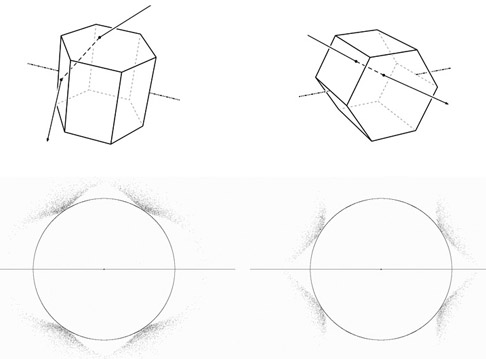
46° contact arc is formed by Lowitz-oriented crystals and it divides in three components. One of the components comes from raypaths that pass through prism face that is parallel to the Lowitz axis. This component is found straight above and below the sun. In spinning crystals light ray can enter both prism and basal face (1-3 / 3-1 type).
Two other components (shown above for 0° sun elevation) are formed by raypaths that pass through prism face that is at an oblique angle to the Lowitz axis. They are distinguished by the ray either entering (4-1 type) or exiting (1-4 type) this face. These arcs are not in the solar vertical and their position changes with sun elevation.
See simulations (Jukka Ruoskanen's software) where 46° contact arc components are shown from spinning crystals for different sun elevations ( 3 - 4 ). Normally, though, halos from Lowitz orientation are not indicating spinning-type orientation distribution. Rather, we will see 46° contact arc from either plate-Lowitz or Parry-Lowitz orientation ( 5 ).
On most sun elevations 46° contact arc components conform deceptively the curvature of the 46° halo. Circumzenith arc also can overlap upper components. Because of the delicate form of 46° contact arc, it may be very difficult to observe in high clouds. Chances are certainly better in uniform diamond dust.
Marko, thanks for making all these simulations. This blog posting is very informative and useful!
ReplyDelete